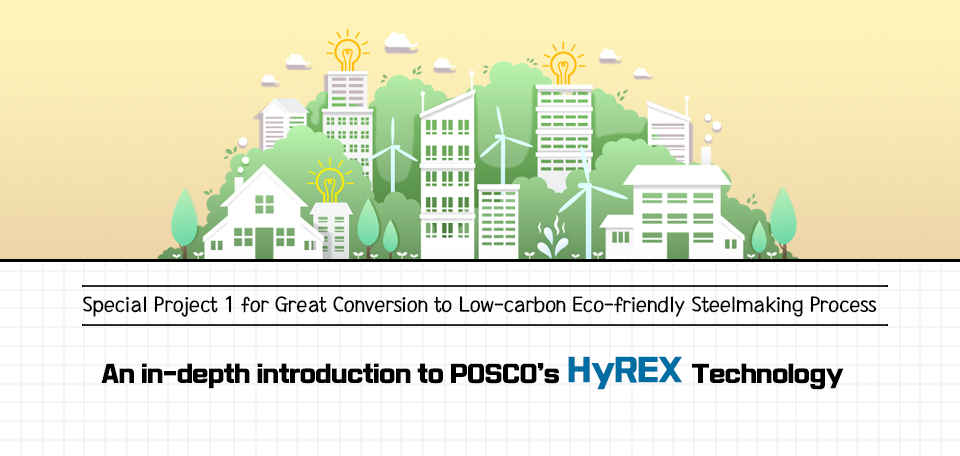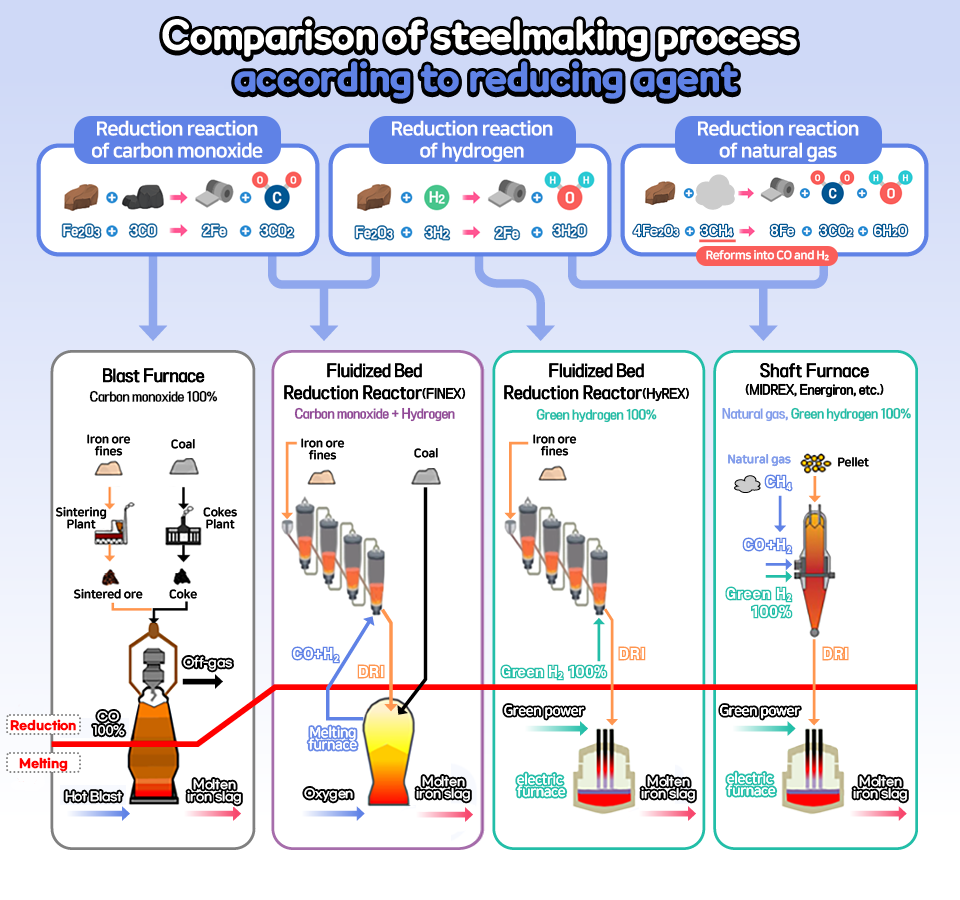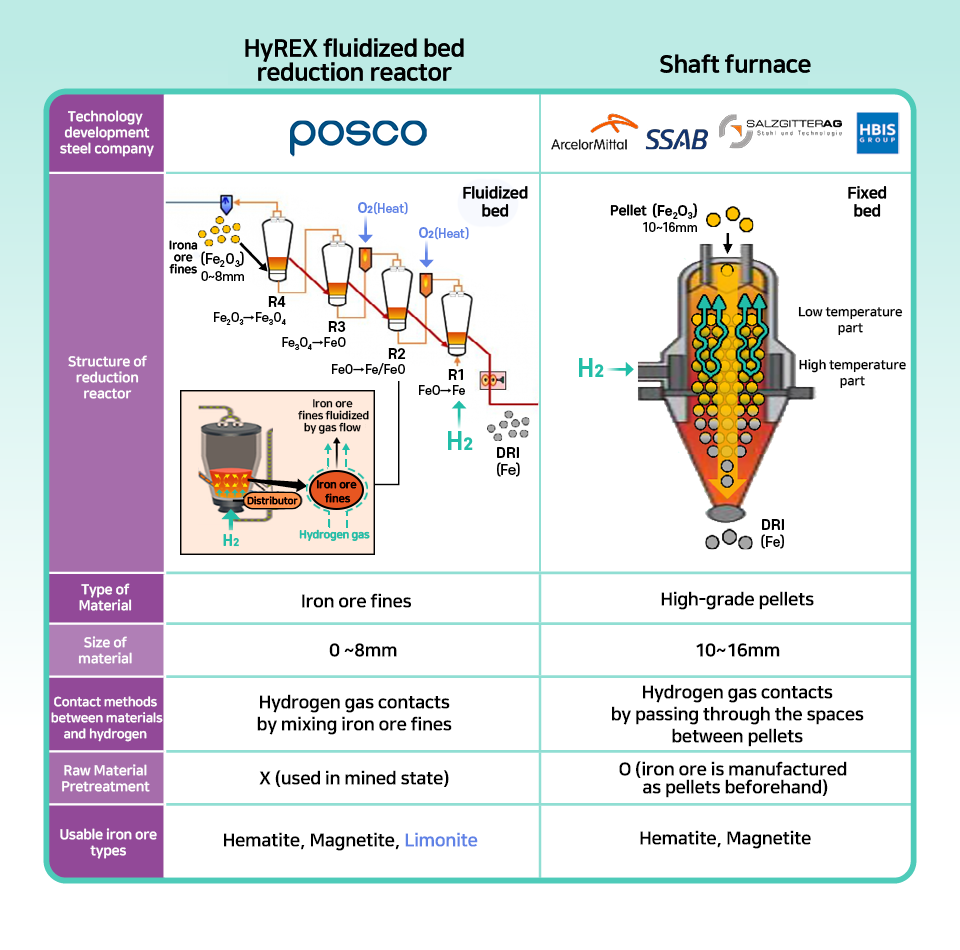In the era of net-zero carbon, the steel industry faces a big challenge. Externally, the demand by the market and customers for low-carbon products is increasing every year amid the crisis of global warming, while the development of new technologies and large facility investments are required internally to reduce the carbon generated in the steelmaking process. Steelmaking processes that have been used for decades should be converted to a low-carbon system from equipment to technology and materials, so it is not an exaggeration to say that the “survival” of steel companies depends on net-zero carbon.
In the series on the “Great Conversion to Low-carbon Steelmaking Process,” we will take a look at the methods of executing net-zero carbon POSCO is promoting to achieve the goal of “net-zero carbon 2050,” such as the development of hydrogen reduction steelmaking, expansion of renewable energy, and CCS, to find a way to “survive.”

l Concept of HyREX and Hydrogen Reduction Steelmaking
Hydrogen reduction steelmaking is an innovative technology that produces iron using hydrogen (H2) instead of fossil fuels. When fossil fuels such as coal and natural gas react chemically with iron ore, they generate carbon dioxide (CO2), while hydrogen only generates water (H2O). Therefore, hydrogen reduction steelmaking can dramatically reduce carbon emissions in the steelmaking process.
HyREX (Hydrogen Reduction) is a steelmaking method that manufactures molten metal using iron ore fines and hydrogen based on the FINEX fluidized reduction technology POSCO has.
l The Fluidized Bed Reduction Reactor is a Core Equipment of Hydrogen Reduction Steelmaking
A common feature of coal, natural gas and hydrogen is that they play the role of a reducing agent that takes oxygen (O2) from iron ore (Fe2O3). The core of hydrogen reduction steelmaking is the reduction furnace, a device where the reduction reaction of iron ore by hydrogen occurs.

In the traditional steelmaking process, a blast furnace plays the role of a reduction furnace. A blast furnace is operated as ore and coal are processed into a form that is suitable for use and put into the blast furnace and hot air is introduced. The hot air burns the coal and carbon monoxide gas generated in this process causes a reduction reaction that takes oxygen from the ore. Also, 1,500℃ or higher heat generated inside the blast furnace makes molten iron, causing a reaction that melts ore. In other words, a reduction reaction that takes oxygen from ore and a melting reaction that melts reduced solid iron (Fe) occur at the same time with coal in the blast furnace.
However, in the hydrogen reduction steelmaking process, the reduction reaction and melting reaction occur in a reduction furnace and electric furnace, respectively, not in a blast furnace. First, iron ore (Fe2O3) contacts hydrogen heated to a high temperature to make iron (Fe). The iron made this way is called direct reduced iron (DRI). After that, if DRI is put into an electric furnace and melted, molten iron is produced.
The reason why the core of the hydrogen reduction steelmaking is a reduction furnace is that it produces DRI using 100% hydrogen, which has not been commercialized yet globally. With current technologies, it is possible to produce DRI using some of the hydrogen generated in the process of using coal and natural gas. Also, with POSCO’s FINEX technology, about 25% of the hydrogen generated during the use of coal is used in the reduction of iron ore. POSCO is preparing to promote the development of HyREX technology that uses100% hydrogen based on fluidized reduction furnace technology applied to FINEX with the Korean government and steel companies. On the contrary, European, U.S., Chinese and other overseas steelmakers are promoting the technical development of a shaft furnace that reforms natural gas (CH4 ) into carbon monoxide (CO) and hydrogen (H2) gases for use.
POSCO held Hydrogen Iron & Steel Making 2021 (HyIS 2021), the first international forum on hydrogen reduction steelmaking, in October last year. In this event, POSCO introduced HyREX technology to global steel companies for the first time. The fluidized bed reduction reactor applied to HyREX is hydrogen reduction steelmaking that is completely differentiated from the shaft furnace method overseas steel companies use, from the type of iron ore to the method of contacting hydrogen. POSCO plans to enhance its future global steel technology leadership by verifying HyREX technology by 2030 and leading the era of sustainable steel.
l Differences between HyREX Fluidized Bed Reduction Reactor and Shaft Furnaces of Other Steelmakers
Then what is the difference between POSCO’s Fluidized Bed Reduction Reactor and the shaft furnaces of other steelmakers? There are three main differences.
First, a difference in materials. A shaft furnace uses pellets, iron ore that was crushed and screened and then processed in a round shape with a certain size, while a fluidized bed reduction reactor uses iron ore fines, which is just mined without processing.
Second, a difference in methods of contact between materials and hydrogen reduction gas. In a shaft furnace, hydrogen, a high-temperature reduction gas, passes through empty spaces between pellets from bottom to top, causing a reduction reaction of the pellets. The reduced pellets become DRI by going into the reduction furnace and coming out.
Gas permeability in the shaft furnace is important for reduction gas to pass smoothly through the spaces between pellets, so iron ore is processed as pellets with a certain size and strength, for use.
On the other hand, in a fluidized bed reduction reactor, high-temperature reduction gas is evenly distributed through a perforated grid at the bottom of the reactor to fluidize iron ore fines and causes a reduction reaction by mixing the iron ore as if mixing liquid. The reduced iron ore fines become DRI after going through multi-stages reactors. Due to such differences in contact methods, the fluidized bed reduction reactor can use iron ore fines without pretreatment .
Third, a difference in carbon emissions. Generally, 50 – 150 kg of CO2 is emitted when 1 ton of pellets is produced. This means that for a shaft furnace to minimize carbon emissions, renewable energy such as wind energy or solar energy should be used for manufacturing pellets. On the contrary, in the case of the fluidized bed reduction reactor that uses iron ore fines, there is no concern about carbon emissions as with the pellet process.

l Why Did POSCO Develop HyREX Technology?
The reason whyPOSCO developed HyREX hydrogen reduction steelmaking technology, to which fluidized bed reduction reactor is applied, not shaft furnace, is mainly divided into material aspect and equipment technology aspect.
First, in terms of material, it is easy to secure materials for HyREX, and production is economical because iron ore fines can be used as they are. As of 2020, the world’s iron ore production is 1.8 billion tons, of which the pellet supply is 420 million tons. This means that the current pellet supply cannot satisfy global steel demand. In December last year, the International Iron Metallics Association (IIMA) predicted that the world will face a supply shortage of pellets for DRI by 2030 without additional investment in material production and innovation in steelmaking technology (see related article).
We can increase pellet production. However, there is a limitation to this. Pellets are mainly produced in Europe and the United States using only hematite and magnetite, and these ores account for only 30% of global iron use. Limonite, which is difficult to use for pellets, accounts for the remaining 70%. Also, in terms of cost, the price of iron ore fines as of 2021 was lower than that of pellets by USD 85 per ton and this is because additional processing of iron ore fines is needed to produce pellets.
There are various types of pellets according to grade. However, since low-grade pellets can degradate and generate powder and agglomerates in a semi-molten state, which decreases permeability and makes DRI discharge difficult, expensive high-grade pellets are usually used for shaft furnaces.
In July last year, the global consulting company McKinsey & Company expressed concern that limited production of high grade raw materials could hinder the Sustainable conversion of the steel industry (see related article). Given that there are just 49 million tons of high-grade pellets to produce DRI out of 110 million tons in the world’s port traffic, except for consumption in the nations that produce pellets, it seems that the competition over high-grade pellets among steel companies will become fiercer.

Next, in terms of equipment technology, a fluidized bed reduction reactor has an advantage for controlling temperature of the bed compared to a shaft furnace. The temperature control technology for a reduction furnace is critical in hydrogen reduction steelmaking, as iron ore causes reduction defects if the heat in the reduction furnace is low. The reduction reaction of iron ore using fossil fuels such as coal or natural gas is an exothermic reaction that self-generates heat, while the reduction reaction of hydrogen is an endothermic reaction that absorbs surrounding heat when it contacts iron ore, easily causing a shortage of heat in a reduction furnace. In other words, heat should be continuously supplied to the reduction furnace from outside and controlled to prevent reduction defects caused by low temperature.
Heat in a reduction furnace is supplied by high-temperature hydrogen reduction gas heated by reaction with oxygen. A fluidized bed reduction reactor consists of a multi-stage reactor where several reactors are arranged in the shape of stairs, and each reactor can control temperature through additional oxygen input. Heating is possible on the walls as well as the bottom of the reactor, so injection of reducing gas at 900℃ or less can cause a sufficient reduction reaction. A shaft furnace, however, consists of a single-stage reducing furnace, and thus the temperature of the whole reduction furnace should be controlled by only the heat of reduction gas injected at the bottom. Therefore, the temperature of the top of the reduction furnace can easily become lower, and it needs injection of high-temperature reduction gas at 1000℃ or more.
Global steel companies are developing hydrogen reduction steelmaking, which partially adds hydrogen in a shaft furnace that currently uses natural gas as a reducing agent. Shaft furnaces are mainly divided into types according to the natural gas reforming method and operation pressure. ArcelorMittal, a multinational steel manufacturing corporation, adopted the MIDREX method, which requires high equipment investment, although its operation stability is high because it occupies 60% of global DRI, while Swedish corporation SSAB and German company Salzgitter adopted the Energiron method, which is relatively favorable to hydrogen conversion, as equipment investment costs and sunk costs are low. SSAB has produced 1 ton of DRI per hour in the pilot stage of the HYBRIT project.*
* Hydrogen Breakthrough Ironmaking Technology (HYBRIT) project: A joint project between Swedish steel company SSAB, iron ore production company LKAB, and energy company Vattenfall for promoting Sustainable steel production.
The International Energy Agency (IEA) predicted in a report (see related article) in October 2020 regarding the prospect of hydrogen reduction steelmaking commercialization that it will take a considerable time to develop the technology to overcome the heat shortage of reducing furnaces and limitation of raw materials for 100% hydrogen conversion of shaft furnaces.
l Plan for Commercialization of HyREX
POSCO will build a test facility with annual production of a million tons in Pohang Works by 2028 in cooperation with the government and Korean steel companies to confirm the possibility of commercialization of HyREX technology, a hydrogen reduction steelmaking method based on FINEX fluidized bed reduction reactor technology. This means a technical confirmation of the difference between fluidized reduction operation and existing FINEX to convert the existing method where the carbon monoxide (CO) of FINEX fluidized reduction furnaces is partially mixed with hydrogen or 100% hydrogen. Also, process technology for a new electric furnace dedicated to hydrogen reduction steelmaking is being developed. DRI made of fossil fuel has a small amount of carbon due to carburization reaction. If DRI has carbon, the melting point of iron (Fe) is lowered by 200~300℃ from 1538℃, making melting easier. On the other hand, DRI produced using 100% hydrogen has no carbon at all, and melting is relatively difficult. Therefore, there is a need to develop a new type of electric furnace technology that is different from existing electric furnaces.
POSCO has successfully produced a cumulative 34 million tons of molten metal in a FINEX plant since the start of FINEX technical development in 1992 and the commercialization of the technology in 2007. In general, the technical development stage leads to the expansion of commercialization through the lab (verification of concept), pilot (verification of consecutive process) and demo (verification of commercialization) stages. However, POSCO plans to enter the demonstration stage from 2025 without a pilot stage and verify HyREX technology in 2030 based on its technologies and experience from FINEX process development. Also, POSCO plans to convert existing blast furnaces in the Pohang and Gwangyang steelworks to hydrogen reduction steelmaking in a phased manner by 2050.
